|
2016 February
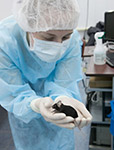
The launch of the second biosatellite will take place in 2022 in the frame of the program BION-M №2 realized by Roscosmos and Russian Academy of Sciences. Biosatellite BION-M №2 will take a 30-days space flight in a circular orbit at the altitude of 1000 km. In 2016 SSC RF Institute of bio-medical problems of RAS, being the leading institution of the project, starts to create the scientific program of investigations and invites interested institutions to take part in animal investigations.
The aim of animal investigations in the frame of BION-M №2 program is the study of system, cell and molecular mechanisms of mammalian body adaptation to long-term combined effects of microgravity, space radiation and other factors of the space flight, as well as mechanisms of readaptation to the gravitation conditions after returning to Earth.
2015 July
Roscosmos signed the contract with SRC Progress for manufacturing space apparatus for conduction biomedical experiments BION-M#2.
“At present SRC Progress and IBMP RAS are negotiating due to contract signature. Official start of works has been given”, said Deputy Director of IBMP RAS Dr. Sychev. “In December Space Council of RAS determinated preliminary list of equipment, which can be installed on board of the satellite, it also approved IBMP as a leading institution for development of a scientific program and determination of a space equipment complex”.
2015 February
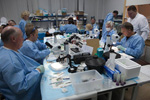
Researchers from IBMP and University of Florida managed to find an answer for the question why cosmonauts’ long exposure to weightlessness sometimes causes vision disorders. The conclusion was made after analyzing results of the experiments conducted by Russian biologists on board of BION-M#1 SC, which had been carried in the orbit in April 2013.
Joint work of researchers was published in Journal of Applied Physiology.
2014 November
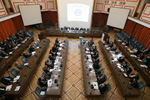
On November 18 2014, the Russian Academy of Sciences has begun work XV Conference on Space Biology and Aerospace Medicine with international participation. The theme of this year's conference was the project "Bion-M» №1: results and prospects of experiments and research. The organizers of the conference were Russian Academy of Sciences, Federal Space Agency, the federal agency research organizations and the Institute of Biomedical Problems, Russian Academy of Sciences. The conference was attended by representatives of space agencies and scientists in the US, Japan, France, England, Germany, China, Iran and other countries.
2014 September
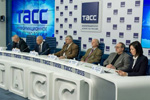
On September 26 2014 in ITAR-TASS News Agency a conference was held. Preliminary results of biological experiments, carried out on board of Foton-M No.4 SC, were announced. Head of Foton-M No.4 project, Deputy Director of IBMP RAS Dr. Sychev, Head of Space Technologies Department of «Research Institute of Launching Complexes» (filial «TsENKI») named after V.P.Barmin A. Egorov, Head of Laboratory of Research Institute of Human Morphology, Principal Investigator of geckos’ experiment Dr. S. Savelev, Deputy Director of TsNIIMash A. Ivanov took part in the conference.
“Flight of Foton was successful in general. We are going to continue this direction of research”, summarized V. Voron, Head of Department of Fundamental Space Researches and Space Complexes of Technological Application of Roscosmos.
2014 September
The ground control experiment in scales of the Foton-M No.4 research SC program was successfully finished.
2014 September
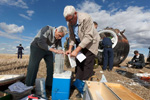
On September, 1 at 13:18 Moscow time Foton-M No.4 SC landed in designated position of Orenburg district. After removing biological objects out of the spacecraft for preliminary examination it was found that fruit flies survived the flight successfully, were able to develop and reproduce themselves. All geckos unfortunately died. Data and conditions of their death will be specified. At present the scientific equipment are being prepared for transportation to the laboratories of the scientific institutes.
2014 July
On July, 19 at 00:50 Moscow time carrier rocket Soyuz-2.1a with Foton-M No.4 SC was launched from cosmodrome Baikonur. In accordance to the flight timeline at 00:58 Foton-M No.4 SC (manufactured by SRC Progress, Samara) was carried in the orbit.
2014 July
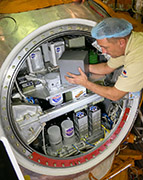
In the night of July, 16 upload of scientific equipment and biological objects in the Foton-M No.4 SC was successfully finished. Installation and testing of equipment proceeded normally. On July, 19 5 geckos, fruit flies, plant seeds and numerous microorganisms will be launched in 2 month flight. During this time more than 20 experiments will be conducted (including the ones, prepared by children).
Foton-M No.4 SC is designed to accommodate experiments in microgravity, to obtain new information about weightlessness physics, to develop technological processes of production of semiconductor materials and medicines with improved features, to conduct biological and biotechnological researches.
Mass of the spacecraft will be 6840 kg, mass of the scientific equipment is up to 850 kg (up to 600 kg inside of the SC and up to 250 kg outside of the SC). Active shelf life on the orbit is 60 days. Average height of the Foton-M No.4 SC orbit is 575 km, which is higher than an average height of the ISS orbit (around 400 km).
2014 May
Information message:
Launch of Foton-M No.4 research spacecraft is planned on summer 2014 from cosmodrome Baikonur, Kazakhstan.
Flight duration: up to 60 days.
Launch place: Orenburg, Russian Federation.
2014 February
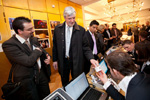
Information Letter.XV Conference on Space Biology and Aerospace Medicine with international participation "BION-M1 PROJECT: Results and Forward Plans". The Conference is open to Bion-M1 participants and all other interested parties
Beginning with March 03, 2014, Conference participants should use the site www.bion-m.com to register, pay registration fees, and find more detailed information about the Conference.
Working languages: Russian and English.
Goals of the Conference:
- Present and discuss the results obtained from the implementation of experiments and investigations of the Bion-M1 project;
- Exchange information with foreign participants covering biological investigations performed after the Bion-M1 flight;
- Inform the science community about results and forward plans for space biology research.
Major Topics:
- Experiments on gravitational physiology of animals (mice, lizards, snails);
- Experiments on gravitational biology, astrobiology and biotechnology;
- Radiation biology and radiation physics investigations;
- Engineering and managerial support of the implementation of the Bion-M1 research program;
- Round table discussion of future space biology research projects.
Points of contacts:
Administration: Denis V. Rakov. Phone: +7-499-195-6835, 7-926-246-0653, E-mail: biosputnik1@gmail.com.
Press: Mark S. Belakovsky. Phone/Fax: +7-499-195-1500, E-mail: info@imbp.ru.
Official service agent: Agency of Congress Management "MAKO". Project manager: Dmitry Tarasenko. Phone: 7-499-705-7925; E-mail: dt@makongress.ruю

2013 September
Мemorandum on the results of studies conducted in mice after a 30-day space mission BION-M № 1.

2013 May
May 22 IBMP RAS hosted a conference following the flight of spacecraft "Bion-M» №1.
2013 May
 OMEGAHAB Post-Landing Report
OMEGAHAB Post-Landing Report
IBMP, May 20, 2013
M. Braun (DLR, Germany), P. Sickinger (KT, Germany)
After the 30-days flight, the bioregenerative life-support system OMEGAHAB on board BION-M1 landed on Sunday, May 19, 2013, near Orenburg. About one and a half hours after landing OMEGAHAB was dismounted from the BION-M1 capsule and was opened and checked. No fish and crustacean were found in the aquarium and only the shells of dead snails remained. The few remains of the water plant Ceratophyllum showed etiolement indicating growth under low or no light. The microalgae Euglena had survived. They had proliferated successfully and tests confirmed good physiological fitness and precise graviorientation (gravitaxis).
The failure analysis is ongoing. All available telemetry and onboard data have to be checked thoroughly. The closed ecosystem has worked successfully during the first 12 days of the mission. Thereafter, telemetry data showed a drop of the oxygen concentration in the fish tank which indicates that the microalgae and Ceratophyllum did no longer produce oxygen for the animals. Based on telemetry data and a first visual inspection of the electronics, mechanical components and experiment units, a possible cause for the experiment anomalies was attributed to a failure of the illumination board.
In the dark Euglena switched from photoautotrophic to heterotrophic metabolism feeding on organic nutrients, thus, proving their high adaptability to adverse environmental conditions. Samples of Euglena collected after landing enable further molecular and physiological analyses.
In conclusion, despite the loss of fish, snails and crustacean, OMEGAHAB was partially successful. The regenerative life support system worked successfully until the illumination was switched off due to a technical failure. The oxygen-producing microalgae component survived. Evaluation of the on-board video and housekeeping data recordings will provide detailed information on the swimming behavior of the fish and microalgae during the nominal operation and on the total scientific gain of the OMEGAHAB experiment.
2013 May
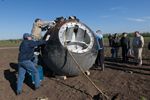
On 19th of May at 07.12 the Landing Module BION-M1 successfully touched down at Orenburg region. Specialists of CSKB, IBMP RAS and other organizations, that take part in the research program and search and rescue operations, were transported at the landing site for work by Air Force helicopters. More than 30 biological, astrobiological, exobiological, microbiological, radiobilogical and other scientific experiments were conducted at the board of BION-M. For the first time there were different biological objects on the orbit, from microorganisms to mammals, which stayed there during 30 days. At the landing site specialists set up a field laboratory where they conducted primary research of the biological material and 12 hours later all biological material and scientific equipment, that had been taken out from the Landing Module BION M1, were transported at IBMP to carry out researches. Primary inspection at the landing site showed that not all biological objects returned to Earth alive. 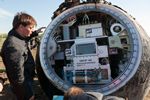 Unfortunately, due to the off-nominal work of equipment more than a half of mice died as well as all 8 gerbils. Other biological objects (geckos, snails) returned to Earth alive.
In spite of the loss of the part of animals, scientific program of research of mammals will be done almost fully, because on the base of long experience of space biological researches at manned and unmanned space modules every space program is planned taking into account possible death of biological objects during space flight.
2013 April
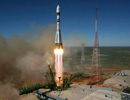
April 19, 14 hours, 00 minutes (msk) from Launch Complex 31 of Baikonur Cosmodrome conducted a successful launch of a space rocket "Soyuz-2.1a" with scientific spacecraft (SV) "Bion-M» № 1.
SV "Bion-M" was created in the "TsSKB Progress" (Samara) in accordance with the Federal Space Program of Russia. The implementation of the scientific program of SV "Bion-M" owned by the Institute of Biomedical Problems Russian Academy of Sciences.
2013 February
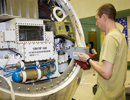
On February 18, accompanied by the specialists of Samara "TsSKB "Progress", SV "Bion-M" and carrier-rocket "Soyuz-2.1b" were delivered to launch area Baikonur. After the receiving of the train carriage from Samara, SV and the carrier-rocket will be delivered to site 112 of the launch area, where the planned works on preparation for the launch will begin.
"Bion-M", part of the Federal Space Program, will conduct fundamental and applied research in space biology, physiology and biotechnology while in orbit. The satellite will carry 24 sets of research instruments and equipment installed both inside and outside the spacecraft.
2012 June
Bion-M1 is scheduled to launch April 15 - 25, 2013.
2011 February
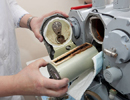
Bioengineering tests of animal habitats (MLZh-01-01) were performed from February 8, 2011 through March 14, 2011 at the habitat’s manufacturer - Biophyspribor (St.-Petersburg, Russia). The habitats will house mice and geckos in the space environment (microgravity). Bion-M1 will carry 3 mouse habitats, each housing 15 C57Bl/6 mice. A mouse habitat consists of 5 boxes, each containing 3 animals. A gecko habitat will house 5 specimens. It is expected that Bion-M1 will remain in orbit for up to 30 days.
2010 Novembe
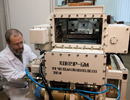
Bioengineering tests of the Kontur-BM unit were performed from November 5, 2010 through December 3, 2010 at the Institute of Biomedical Problems, Russian Academy of Sciences. The unit equipped with a self-contained life support system will house Mongolian gerbils (Meriones unguiculatus). The tests were carried out on 8 gerbils with other 8 gerbils used as controls.
|

